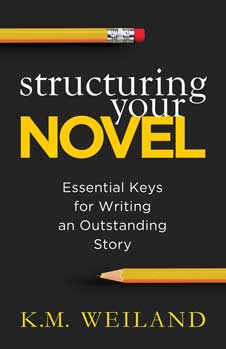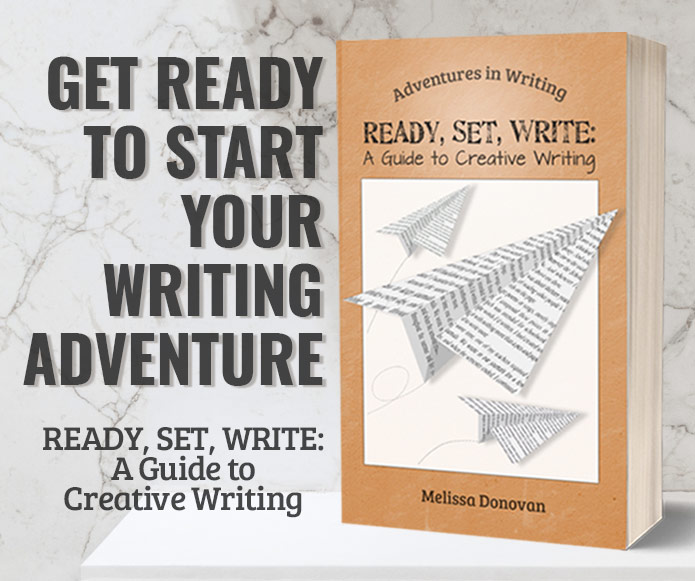Please welcome author K.M. Weiland with a guest post on structuring your novel.
Take moment to think of some of the most significant scenes in your favorite stories.
More than likely, the scenes that pop to mind are those in which major events occur: Jane meets Mr. Rochester, the Titanic hits the iceberg, Darth Vader kills Obi-Wan. These are some of the most dramatic scenes in film and literature. They’re scenes that move their respective plots forward by leaps and bounds.
These are called plot points.
As we’ve already noticed, plot points are significant events. They’re game changers within your story. They’re turning points.
How many plot points are in a story?
Depending on the length and pacing of your story, you could have any number of plot points. In some sense, every single scene offers the potential for a plot point. Whenever something happens that changes your protagonist’s understanding of the conflict and his or her understanding of how to react to it, you’ve got yourself a plot point.
But speaking more specifically, every story has three major plot points that must be given special attention. We find these plot points at roughly the 25%, 50%, and 75% marks (I discuss the flexibility of the plot points’ timing in more depth in my book Structuring Your Novel: Essential Keys to Writing an Outstanding Story) (aff link).
The first major plot point
Our first plot point, which lands roundabout the first quarter mark, signifies the end of the first act. Although all sorts of exciting things have no doubt happened already, this plot point, more than all the previous ones, signals a change of pace for the protagonist. In one sense or another, everything up to this point has been set up.
But when the first major plot point hits at the end of the first act, everything changes. Your character can no longer walk away from the conflict. Whatever happens at the first plot point will invest your protagonist so deeply in the plot that he or she has no choice but to spend the first half of the second act trying to react to it.
When Jane meets Mr. Rochester at the quarter mark of Charlotte Brontë’s Jane Eyre, her world is effectively changed forever. As the new governess at Thornfield, she can’t go back to the person she was before. From the very first moment she meets Rochester, her world begins to change.
The midpoint
Halfway through your book (and halfway through the second act), we find the second of our major plot points. Like the first major plot point, this one is going to rattle your character’s world all over again. But the major difference here is that this plot point is going to shake your character out of the reactionary stage that followed the first plot point. From here on, the protagonist is going to start taking deliberate action against the antagonistic force.
In James Cameron’s film, when the iceberg hits the Titanic, Rose is unequivocally forced out of her reactions to having met Jack Dawson. She, and everyone else on the ship, is compelled to start taking action in order to save their lives. This is a particularly great example of how big a midpoint can be. Legendary director Sam Peckinpah calls the midpoint the centerpiece of your story—so make it shine!
The third plot point
At the 75% mark in your story, your second act will end and your third act will begin with your third and final major plot point. This will almost always be a low point for your character. All of his or her actions since the midpoint will seem to have led to tragedy. Allies will have died, people will have betrayed your character, or he will have messed up so badly he fears he can never be redeemed. But from these ashes, the protagonist will rise into a new series of actions, even more determined than before. This new determination will carry him right up to the climax.
In the third plot point of George Lucas’s Star Wars: A New Hope, we find the heroes escaping the Death Star—but at the tremendous cost of Obi-Wan Kenobi’s life. Luke must rise from his own grief and confusion with a final resolve to do whatever is necessary to protect the rebel base on Yavin IV.
Always plan your major plot points carefully—and then double check them. What’s happening at the quarter marks in your story? Are your plot points firmly in place? What could you do to strengthen them even further? The more solid your plot points, the stronger your story’s entire foundation will be.
About the author: K.M. Weiland is the author of the epic fantasy Dreamlander, the historical western A Man Called Outlaw and the medieval epic Behold the Dawn. She enjoys mentoring other authors through her website Helping Writers Become Authors and her books Outlining Your Novel and Structuring Your Novel and her instructional CD Conquering Writer’s Block and Summoning Inspiration (aff links). Find her on Twitter: @KMWeiland.





Thanks so much for hosting me today, Melissa!
My pleasure!
Minor plot correction…the rebel base wasn’t on Yavin IV which is a gas giant. The base was on a habitable moon of Yavin IV…which leads to a plot hole since apparently the Death Star wasn’t powerful enough to take out a gas giant which would have solved the empire’s problem much more efficiently.
You’re totally right! Can’t believe I forgot that. :p
Oh…and great article. Thanks for sharing.
Between K.M. and Larry Brooks, I’ve got the plot points embedded in my skull forever. Now plotting is the hardest part of my writing. I’ll anguish for weeks over the major plot points. I know if I’ve nailed those, the rest will flow much better.
It will get easier with time and practice!
Interesting post. I suppose you could use similar pacing to show the development of a character who proceeds from evil to not-so-evil as a result of several life-altering events.
Ooh, sounds intriguing!
Thank you for writing this article. I’m was looking for a site that would help my 12 yr. old granddaughter understand plot points for school work, and your article defined it perfectly. You made it simply and easy. You did not go off digress; like a lot of articles by adding unnecessary ideologies which just throws the reader off.
I can’t wait for her to get home and read your article, I think this will give her what she needs to understand plot points much better.
Again, Thank You!
Gail, thank you for taking the time to share these kind words. It means so much to me. Comments like yours keep me going. Thank you!